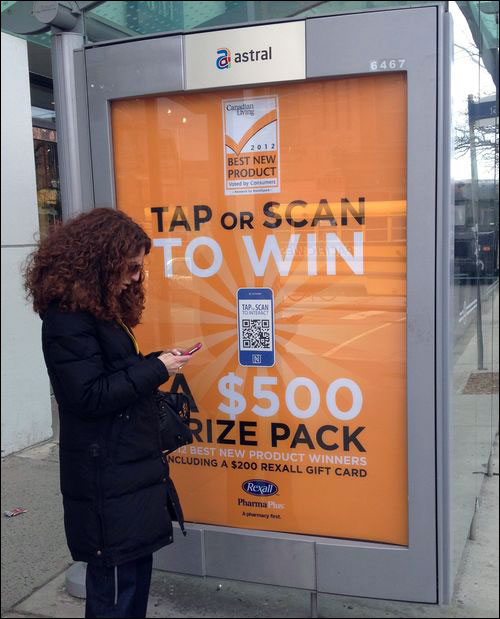Two advertising companies are testing a Near Field Communication (NFC) RFID and 2-D bar-code solution provided by Vancouver mobile marketing technologies firm GaugeMobile that would allow consumers to access data from posters deployed throughout Canada using a smartphone. The system, known as Scanvee, has been installed at transit shelters, as well as in numerous bar and restaurant bathrooms, in order to entice members of the public to join a contest to win consumer goods. The campaign will include more than 1,000 posters for each advertising company, disseminated across the country.
Astral Outdoor and indoor advertiser Newad Media hope the system will draw consumers’ attention to products and services promoted on billboards and posters. The initial trial, which began approximately one week ago, consists of a contest for a $200 gift certificate for Rexall Canadian Pharmacies, as well as a basket of consumer goods from such companies as Procter & Gamble and Kimberly Clark. The Out-of-Home Marketing Association of Canada (OMAC) is running the contest, as part of an advertising campaign.
A Scanvee tag contains a passive NFC RFID inlay and is printed with a QR code, both of which are encoded with a unique ID number. During the promotion, Scanvee tags are being affixed to frames surrounding Newad advertising posters, which are being installed within restaurant and bar bathrooms (both women’s and men’s) throughout Vancouver, with 10 posters currently in place. Each poster contains a message inviting those who see the poster to enter the contest by tapping his or her NFC-enabled phone near the Scanvee tag—which measures 6 centimeters by 12 centimeters (2.4 inches by 4.7 inches)—or by scanning the QR code printed on it. Whether NFC technology or a QR code is used, the content is provided via the mobile phone’s cellular connection to the Internet (where Scanvee software manages the data on GaugeMobile’s server), and the individual is then asked to enter his or her name and e-mail address in order to qualify for the drawing. One month later, after the drawing has taken place, the winner will receive a notification via e-mail.
The Astral Outdoor system has been installed at five transit shelters in Toronto, where commuters await city buses or streetcars. Here, travelers are also invited to scan the QR code printed on the poster, or to read the NFC tag embedded beneath the QR code, to qualify for the contest.
The trials, launched earlier this month, are expected to continue for 12 months, after which the advertising companies and GaugeMobile intend to evaluate the results. The OMAC contest will continue for four weeks, and Astral Outdoor and Newad expect to launch another campaign upon its completion.
The number of NFC reads performed on any of the posters or billboards is expected to be a small fraction initially, compared with 2-D bar-code scans. “The market is still very young for NFC technology,” says Tony Vassiliev, GaugeMobile’s CEO. Since he estimates that about three percent of phones currently in use are equipped with NFC readers, only a few individuals will utilize the NFC capabilities until the technology becomes more prevalent. For that reason, the 2-D QR bar code is included with an NFC chip on the posters.
The GaugeMobile software enables an advertiser to ask consumers to opt in to future promotions, Vassiliev says, but the two participating advertising firms have not taken advantage of this feature so far. Instead, they simply wanted to test how well the system attracted consumers’ interest.
Although the majority of consumers may use the QR code, Vassiliev expects the more popular technology in the long run to be Near Field Communication. “The challenge we find for the QR code,” he states, “is that it’s fine for tech-savvy people, but there are many people who don’t want to go through the steps required to scan that code.” Approximately three steps are necessary to scan the QR code: initially downloading the bar-code scanning application, selecting the app and responding to prompts to access the bar-code scan data. The NFC solution does not require that a user download any apps, Vassiliev notes.
Vassiliev says he and his colleagues have spent a few hours in the vicinity of the bus stops, observing the public’s response to the posters, but that he has no statistics at this time regarding how frequently the posters have been scanned or tapped, or what the overall rate of interest has been among those at the bus stops. As the pilot proceeds, he says, the advertising firms will vary the types of products being promoted, enabling them to compare and contrast the level of interest each offering generates.


